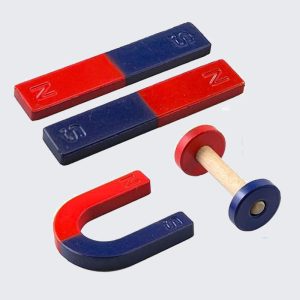Product description
Ferrite magnets or ceramic magnets are permanent magnets that are made up of ferrite chemical compounds. This compound is made up of ceramic materials and iron oxide.
According to experts, there are two types of ferrite magnets are the Strontium and Barium type of ferrite magnets. These magnets are commonly used in electromagnets, electronic inductors, and transformers.
Corrosion-free – Ferrite magnets are corrosion-free which means they can prevent environmental decay. This also means it does not rust further because rust is its main ingredient. This is very much important because this is what makes ferrite magnets last long. They have longer life cycles compared to other magnets.
Non-conductive – Professionals suggest that ferrite magnets are electrically non-conductive. This also means that they are insulators and can be easily attracted to magnets.
High temperature performance – Ferrite magnets can withstand high heat temperatures. These magnets are said to carry on their performance even up to 250 degrees celsius. However, any higher than this can cause degrading levels in its performance.

 The raw material – iron oxide – for these magnets is mixed with either strontium or barium and milled down to a fine powdered form. The powder is then mixed with a ceramic binder and magnets are produced through a compression or extrusion molding technique that is followed by a sintering process. The nature of the manufacturing process results in a product that frequently contains imperfections such as cracks, porosity, chips, etc. Fortunately, these imperfections rarely interfere with a magnet’s performance.
The raw material – iron oxide – for these magnets is mixed with either strontium or barium and milled down to a fine powdered form. The powder is then mixed with a ceramic binder and magnets are produced through a compression or extrusion molding technique that is followed by a sintering process. The nature of the manufacturing process results in a product that frequently contains imperfections such as cracks, porosity, chips, etc. Fortunately, these imperfections rarely interfere with a magnet’s performance.
What’s the difference between Ferrite magnet and other magnets
Neodymium magnets – Ferrite magnets are stronger than neodymium magnets in terms of breakage. The curie temperature of neodymium magnets is lower than those of Ferrite magnets. This means that Neodymium magnets get demagnetized first before Ferrite magnets when exposed to high temperatures.
Alnico magnets – Based on observational reviews, Alnico magnets are easier to demagnetize than ferrite magnets. This is because alnico magnets are part of the alloy magnet family. An observation on speakers compared resulted in ferrite magnet speakers sound edgy when on high levels compared to those speakers with Alnico magnets.
Samarium cobalt – Samarium cobalt magnets can withstand higher temperature levels than ferrite magnets. Samarium cobalt magnets and ferrite magnets are both resistant to corrosion and good magnetic stability. However, these magnets are said to be brittle.
Magnetic rubber – The most advantageous feature of this magnet is it is flexible and can be cut into pieces. Ferrite magnets and rubber magnets are both corrosion resistant. However, the peak temperature level that rubber magnets can withstand is only at 100 degrees celsius. It has also a low magnet attractive trait than ferrite magnets.
Applications Of Strong Ferrite Magnet
Ferrite magnets can usually be made into 180mm x 120mm x 50mm squares or D200MM discs.
- DC permanent magnet motors, especially for the automotive industry (blowers, window lifts, windshield wiper motors, etc.)
- Separators (removing ferrous materials from liquid, powder, and bulk commodities)
- Magnetic couplings
- Holding-magnet systems
- Sensor applications





